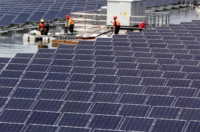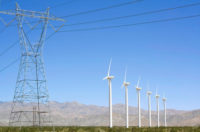Clean energy groups are raising concerns over a proposal now being voted on by International Code Council members that could require utilities to increase the structural stability of power generation facilities they own and operate against natural disaster impacts.
The groups claim enactment of tightened building code standards for utility-owned renewable energy projects could significantly raise building costs and even cancel them.
But engineering and other experts proposing the changes say they are misunderstood and fears are overblown.
The proposal was submitted to the council, known as ICC, which is helping set state building codes as part of its 2024 development cycle, said David Bonowitz, a California structural engineer and member of a committee of engineers and building code experts that advises the Federal Emergency Management Agency and participates in the open code development process with agency support. The changes are not a FEMA proposal, he says.
The proposal, S76-22, designates utility power facilities as “essential” and seeks to elevate them to the highest structural risk category in state and local building codes, Category 4. Opponents claim many solar and wind power facilities are now at lower Category 1 and 2 risk levels, but Bonowitz emphasized that those that are utility owned and operated—and would be affected by S76—are already at Category 3.
A final vote on the proposal is underway by eligible ICC members through Nov. 1. They approved the measure in two previous votes by an overwhelming majority, according to Bonowitz.
The proposing group, members of the Applied Technology Council Seismic Code Support Committee, is engaged by the agency to “support and encourage the adoption and enforcement of seismic provisions in the national model building codes and standards,” said Jon Heintz, executive director of the council, based in Redwood City, Calif., and connected with the Structural Engineers Association of California. The committee has ties to FEMA, which “funds and participates in committee deliberations, and supports and co-sponsors code changes and recommendations [it] develops,” he added.
Renewables: ICC Is Wrong Venue
But the Solar Energy Industries Association, as well as the American Clean Power Association and Distributed Wind Energy Association, urge ICC not to support the changes.
In an open letter, opponents say the risk elevations would raise ground-mounted solar installations, energy storage systems and wind turbines “to the highest level possible, on par with requirements for hospitals and fire stations,” stymie clean energy development and slow climate crisis response.
“Proposal S76-22 is written by structural engineers, not grid reliability experts with experience in the core factors of grid resilience and the interaction of the power generating facility and transmission and distribution systems, both of which are unrelated to structural design loads,” says the letter, which the groups claim has more than 200 signatories, including major utilities such as NextEra Energy and developers such as wind turbine manufacturer Vestas.
SEIA says “there is no extended record of irreparable damage to solar arrays from higher seismic, wind or snow loads,” noting media reports of no lost electricity and minor damage for the solar-powered, 2,000-household Babcock Ranch community 12 miles northeast of Fort Myers, Fla., after Hurricane Ian hit the area Sept. 28.
Joseph Cain, SEIA director of codes and standards, said at a September public hearing that the proposed changes do not solve problems noted by proponents and contain "language that is undefined, ambiguous and conflicting,” which many local authorities will be unable to interpret. “The structural behavior of renewable energy facilities is very different from conventional turbine-based power generation stations for which the risk category table was written,” he said.
Cain also said investor-owned utilities use the National Electrical Safety Code rather than the International Building Code and therefore would not be required to use code levels for their conventional or renewable energy facilities.
Karl Schadlich, Signal Energy Constructors senior business development director, also said at the hearing that an investigation by his team in California showed that a risk elevation from Category 1 to Category 3 increased by 1,100 tons the steel foundation needed for a 100-MW solar project, significantly raising the cost of construction.
Jeroen van Dam, principal engineer for national wind technology at the U.S. Energy Dept.'s National Renewable Energy Laboratory (NREL), testified that renewable energy facilities such as wind and solar have a positive effect on grid reliability because, with them, it is less likely that an area’s entire power generating capacity will be affected by a natural disaster. “This was demonstrated in the case of Hurricane Maria where the Punta Lima wind plant [in Puerto Rico] was impacted by the hurricane, yet the Santa Isabel wind plant located within 50 miles survived,” he said.
Smaller renewable energy power plants have built-in redundancy and have been shown to be quickly deployable compared to coal, natural gas and nuclear power plants, van Dam said. He said NREL is not aware of existing data indicating that if wind energy plants would have been designed to risk Category 4, “the grid would have stayed online or recovered quicker in the wake of natural disasters.”
Van Dam added that the change would drive developers to procure fewer but more expensive wind turbines designed to the higher risk level. “More wind turbines by definition provide more grid resilience and reliability through redundancy,” he said, contending that the proposed change will raise project cost substantially more than proponents’ 2% estimate.
NREL said it plans to perform more detailed independent cost analysis.
Gregory Cooper, technology integration leader at GE Renewable Energy, said the new risk category for wind turbines “would be a significant setback to our goal of improving their economics" and expanding U.S. markets.
The proposed changes would reduce maximum economical tower height from 120 meters to 100 m, he said. Land based towers taller than 120 m are needed to be economical “since the installed cost increases faster than the increased energy production for most sites,” Cooper said.
Essential Facilities
The current vote is normally a “rubber stamp,” Bonowitz told ENR, but the renewable sector opposition has made it more contentious. He argues that essential facilities should be designed to the higher risk standard, adding that Category 4 is the International Building Code’s main tool to have those facilities begin operating quickly after a destructive earthquake, flood, snow, or high wind.
The proposed changes are only for projects regulated as public utilities because they serve the general public, even if they are privately-owned or investor-owned, Bonowitz emphasized, but adding that there are exceptions.
According to Bonowitz, DOE was asked by renewables groups to oppose the proposal but has declined to do so. “FEMA representatives testified at the September hearing that the department requested that FEMA and ATC work with it to develop implementation guidance once the proposal is approved,” he told ENR.
“We know it’s quite workable,” he said, adding that an elevated design standard is required for onshore wind projects in some Midwest states and for solar projects in the southwest U.S.
While opposing S76, “industry is supporting two related proposals, S79 and S81, both submitted by SEIA, that would reduce design requirements for certain installations,” says Bonowitz, who adds that those two proposals already address most of industry's concerns about S76. He said that S76 is compatible with both S79 and S81, and his committee supports all three proposals as a package.
“But without S76 to protect public-serving utilities, the two SEIA proposals by themselves serve only industry and will weaken the code,” Bonowitz said. The proposed changes are not about stricter requirements for renewable installations but “about public utilities that provide power using any fuel source, renewable or new,” he added.
The argument in support of the changes is “simple and self-evident,” the engineer said. Without them, “code users completely ignore the public service nature of a public utility that the risk assignment is meant to reflect.”






Post a comment to this article
Report Abusive Comment